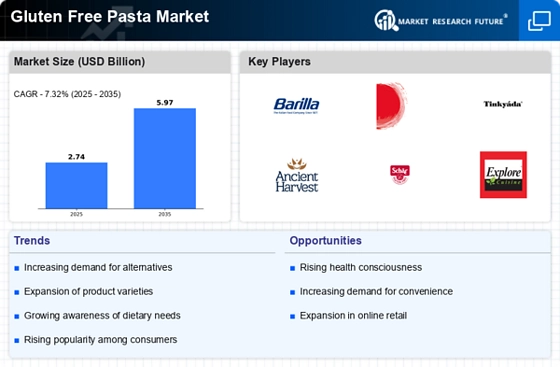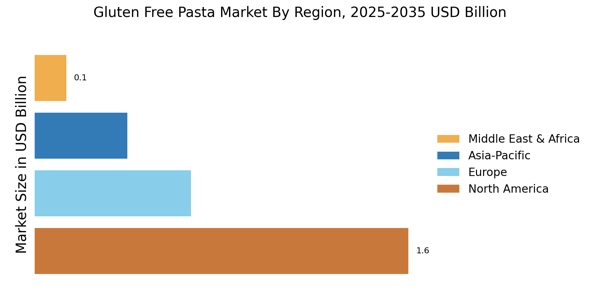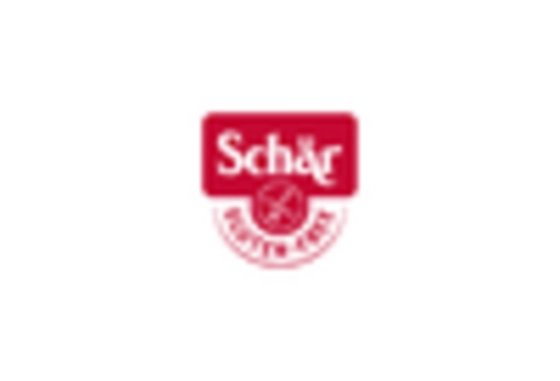Health and Wellness Trends
The ongoing health and wellness trends are significantly shaping the Gluten Free Pasta Market. Consumers are increasingly prioritizing healthful eating habits, leading to a surge in demand for nutritious food options. Gluten-free pasta is often perceived as a healthier alternative, particularly when made from whole grains or legumes, which are rich in fiber and protein. Market Research Future indicates that the gluten-free pasta segment is expected to grow at a compound annual growth rate of around 10% over the next five years. This growth is fueled by the rising consumer interest in clean label products, which are perceived as healthier and more natural. Consequently, the Gluten Free Pasta Market is adapting to these trends by innovating and expanding its product lines to meet the evolving preferences of health-conscious consumers.
Culinary Trends and Innovations
Culinary trends and innovations are playing a pivotal role in the evolution of the Gluten Free Pasta Market. Chefs and food manufacturers are experimenting with various gluten-free ingredients, such as chickpeas, lentils, and quinoa, to create unique pasta varieties that appeal to a broader audience. This innovation not only enhances the taste and texture of gluten-free pasta but also introduces new flavors and nutritional benefits. The market is witnessing a rise in gourmet gluten-free pasta options, which cater to discerning consumers seeking high-quality, flavorful meals. As culinary creativity continues to flourish, the Gluten Free Pasta Market is likely to see an influx of new products that attract both gluten-sensitive individuals and those without dietary restrictions.
Rising Prevalence of Gluten Sensitivity
The increasing awareness and diagnosis of gluten sensitivity and celiac disease are driving the Gluten Free Pasta Market. As more individuals recognize the adverse effects of gluten on their health, the demand for gluten-free alternatives has surged. Recent estimates suggest that approximately 1 in 100 people worldwide are affected by celiac disease, leading to a heightened need for gluten-free products. This trend is not limited to those with diagnosed conditions; many consumers are adopting gluten-free diets as a lifestyle choice, further expanding the market. The Gluten Free Pasta Market is thus experiencing robust growth, as manufacturers respond to this demand by developing a diverse range of gluten-free pasta options, catering to various dietary preferences and needs.
Increased Availability of Gluten Free Products
The expansion of the Gluten Free Pasta Market is significantly influenced by the increased availability of gluten-free products in retail and food service sectors. Supermarkets and specialty stores are now dedicating more shelf space to gluten-free items, making it easier for consumers to access these products. According to recent data, the number of gluten-free product offerings has increased by over 30% in the last few years. This trend is complemented by the rise of online grocery shopping, which allows consumers to conveniently purchase gluten-free pasta from the comfort of their homes. As a result, the Gluten Free Pasta Market is poised for continued growth, driven by enhanced product accessibility and consumer convenience.
Growing Influence of Social Media and Food Trends
The growing influence of social media and food trends is significantly impacting the Gluten Free Pasta Market. Platforms like Instagram and TikTok have become vital for food marketing, where visually appealing gluten-free dishes are showcased, inspiring consumers to try gluten-free options. This trend is particularly pronounced among younger demographics, who are more likely to experiment with new food trends shared online. The visibility of gluten-free pasta recipes and meal ideas on social media platforms has contributed to a surge in consumer interest and demand. As influencers and food bloggers continue to promote gluten-free lifestyles, the Gluten Free Pasta Market is expected to benefit from increased consumer engagement and awareness, driving further growth.


















Leave a Comment